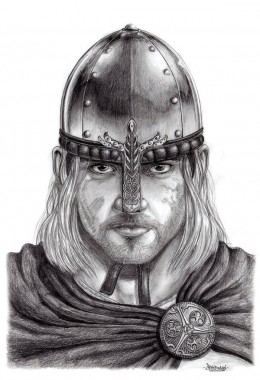Earl Tostig
Events in England soon conspired to render whatever had happened in Normandy increasingly irrelevant as far as Harold was concerned. In the autumn of 1065, the thegns of Northumbria rose up against the rule of Earl Tostig. Whilst Tostig was absent at the royal court, his housecarls were attacked and killed at York, and Morcar, younger brother of Earl Edwin of Mercia, was chosen as earl in his place. The rebels, with Morcar at their head, advanced as far south as Lincoln and then on to Northampton, the southern limit of the northern earldom. Here they joined forces with Earl Edwin (who had Welsh support as well as Mercian) and met Earl Harold. Harold negotiated with them and took their demands (principally the outlawry of Tostig and the recognition of Morcar as their earl) to King Edward at Oxford. The King reluctantly gave in to the rebels’ demands and Harold returned to give the rebels the news. Morcar was confirmed as the new earl and Tostig fled with his wife and followers to the court of his father-in-law in Flanders.
Local grievances dominated the northern rebels’ concerns. Tostig’s relationship with King Malcolm of Scotland, for example, may have been causing unease for some time. Vita Edwardi describes how, in the late 1050s, Tostig had responded to Scottish raids southwards with diplomacy rather than military force. Malcolm and Tostig became sworn brothers and the former acknowledged the superiority of King Edward. However, Malcolm’s unreliability as an ally was demonstrated in 1061 during Tostig’s absence from England on a pilgrimage to Rome. With northern England leaderless, Malcolm raided again, and influential members of England’s northern élite may well have felt that Tostig was neglecting his primary duty of defending his earldom from Scottish attack. If so, their disquiet can only have been compounded after Tostig’s return from Rome when, in 1062, he travelled to Scotland and made peace with Malcolm, reaffirming his earlier agreement with the Scots’ king and effectively accepting the latter’s possession of Cumberland. This was `a serious setback for the security of the North’.
According to John of Worcester, moreover, Tostig’s rule was brutal and cruel: he was responsible for the deaths of two prominent Northumbrian noblemen, whilst his sister (Queen Edith, no less) had ordered the killing of the Northumbrian thegn Cospatric `for her brother’s sake’ at the King’s Christmas court in 1064. Cospatric was the son of Earl Uhtred of Northumbria, who had died in 1016. He therefore had his own claim to the earldom, and his death may hint at the political tensions which remain largely hidden behind the scenes in northern England during Tostig’s rule. That rule was also oppressive for other reasons: Tostig `unjustly levied on the whole of Northumbria’ a `huge tribute’; and even the pro-Godwine Vita Edwardi concedes that he had repressed the Northumbrian nobility `with the heavy yoke of his rule because of their misdeeds’. It is possible that the harshness of Tostig’s regime is overstated in these sources, but the particularly northern concerns of the rebels cannot be overlooked. One of their demands was for the restoration of the `Laws of Cnut’. The laws themselves were not important for their detail as much as for what they were seen to represent, namely `the pattern of northern rule which Tostig’s government had subverted’. This strongly suggests that Tostig had been trying to impose southern laws and, in particular, southern (that is, higher than usual) levels of taxation in the north.
The Vita Edwardi reports a rumour that Earl Harold had actually instigated the rising against his brother. The author takes care to dismiss this possibility (perhaps out of deference to the feelings of his patron, and Harold’s sister, Queen Edith), but clearly states that Tostig himself believed it and that he publicly charged his brother with this treachery before the King. Harold certainly had a great deal to gain from a successful rising. Having recently returned from Normandy, he knew about Duke William’s designs on the throne, and he must have been thinking about the best course to pursue so as to ease his own path to power on Edward’s death. In this context, the support of Earl Edwin of Mercia and his family would have been extremely helpful, and there was perhaps no better way to secure this than by quietly supporting Morcar’s claim to the earldom of Northumbria. In other words, by supporting Morcar, `Harold aligned himself with both Mercians and Northumbrians, a political gain which overrode any familial feelings for a brother whose rule had led to disorder in the north.’ Harold’s marriage at around this time to Ealdgyth, the sister of earls Edwin and Morcar and the widow of Gruffudd ap Llewelyn, was probably designed to set the seal on this newly-established amity between England’s two most powerful families. On balance, it is probably going too far to suggest that Harold stirred up the northern rising; and he may, as the Anglo-Saxon Chronicle claimed, have tried but failed to reconcile his brother with his opponents. The fallout from the events of 1065 nevertheless benefited Harold greatly in the short term; although by abandoning Tostig he created problems which eventually contributed to his own downfall.
For King Edward, the way in which the Northumbrian rising was brought to an end amounted to a personal humiliation. Tostig had been a royal appointee to the earldom of Northumbria in 1055, and it would have been understandable had Edward perceived the rising as a challenge to his own authority. He had wanted to crush the rebels by force, but, as in 1052, his leading subjects effectively ignored him. According to the Vita Edwardi, a furious and raging Edward felt that he had been betrayed and he fretted himself into an illness from which he never recovered. News of Edward’s poor health must soon have reached William of Normandy.
